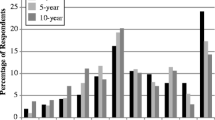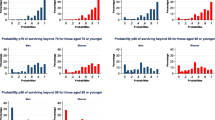Abstract
Biased health care decision making has been regarded as responsible for inefficient behaviours (for example, the limited insurance purchase). This paper empirically examines two sets of biases in the perception of old age disability and longevity. Particularly, we test for the existence of a so called cumulative bias and, secondly’ a so called optimism’ bias. Findings are suggestive of a significant overestimation of disability risks but no overestimation of longevity expectations is found. Both disability and longevity perceptions appear to exhibit a ‘cumulative’ pattern when mapped over time. Healthier individuals are less likely to perceive high disability and longevity risks whilst female and younger respondents perceive a higher risk of disability in old age at a population level but not at an individual level.
Similar content being viewed by others
Notes
However, estimates were affected by focal responses whereby some individuals reported either a 0 or 100% chance of a future event. The same applies to Gan et al. (2003), who use a Bayesian update model to account for problems associated with focal responses.
However, Walley (1991) reviews cases in which individuals consistently respond in the lower and upper ends of the probability tails when asked questions about probabilities, suggesting that numerical probabilities elicited in surveys may be consistently biased toward extremes.
The specific card provided to the interviewer included several potential causes of disability in old age offering (although not necessary assuring) a clear idea of what disability means. The aim was to inform the respondent rather than focus their attention on a specific event. Furthermore, there is evidence in the risk perception elicitation literature of the existence of ‘scope effects’ in that the explicitness of the alternatives is likely to bias the results (Windschitl 2002).
However, these estimates should be conceptualised as ‘maximum risk perception estimates’. Yet the hypothesis of morbidity compression suggests that morbidity declines as life expectancy increases (Fries 1980). Sensitivity analysis using data from Spain among other countries indicates that depending on the assumption of the effect of morbidity on old age disability, these estimates might decline by between ten and 23 per cent (Rothgang and Comas-Herrera 2003).
We employed sensitivity analysis to examine whether prior ages would matter and found that if did not.
It should be noted that this is a relatively common question phrasing employed in several studies (Purim and Robinson 2005). However, given that individuals differ in their predisposition to greater longevity, one of the main challenges of empirical studies is the correction of these measures.
This is consistent with insurance studies; the probability of experiencing losses is not directly observed, instead the probability of loss is proxied by age, gender and pre-existing beliefs (Showers and Shotick 1994).
We experimented with different age group classification by allowing people to have realistic notions of cohort differences in longevity based on their exact age, but it made no difference in the results so that we have reported then by age group instead.
Yet, this finding might well be explained by the presence of some omitted variable, capturing individual ‘optimism’, explaining both perceptions of longevity risks and health status.
Some might well argue that people who live to age 65 have a predicted life expectancy that typically takes them to an age beyond the predicted life expectancy, therefore if that were to be true, our results would imply that this feature si not taken into account.
Given that women tend to live longer, the findings suggesting no gender difference indicate once again that women might even be underestimating their life expectancy, since they may not be taking their age specific life expectancy as a reference point, but rather other forms of information from their own social network or experience.
References
Abellan Garcia, A. (2005). Las personas mayores en España, Datos Estadísticos Estatales y por Comunidades Autónomas, Instituto de Mayores y Servicios Sociales, Madrid.
Finkelstein, A., & McGarry, K. (2003). Private information and its effect on market equilibrium: New evidence from long-term care insurance. WP: National Bureau of Economic Research. 9957.
Fischhoff, B., Slovic, P., Lichtenstein, S., Read, S., & Combs, B. (1978). How safe is safe enough? A psychometric study of attitudes towards technological risks and benefits. Policiy Sciences, 9, 127–152.
Fries, J. F. (1980). Ageing, natural death and the compression of morbidity. The New England Journal of Medicine, 303, 130–135.
Gan, L., Hurd, M. and McFadden, D. (2003). Individual subjective survival curves. NBER Working Papers, 9480.
Gustafson, P. (1998). Gender differences in risk perception: Theoretical and methodological perspectives. Risk Analysis, 18, 805–811.
Hakes, J. K., & Viscusi, K. (1997). Mortality risk perceptions: A bayesian reassessment. Journal of Risk and Uncertainty, 15, 135–150.
Hamermesh, D. S., & Hamermesh, F. W. (1985). Do perceptions of life expectancy reflect health knowledge? American Journal of Public Health, 73, 911–914.
Hayakawa, H., Fishbeck, P., & Fishoff, B. (2000). Automobile risk perceptions and insurance-purchasing decisions in Japan and the United States. Journal of Risk Research, 3, 31–67.
Heckman, J. (1979). Sample selection bias as a specification error. Econometrica, 47, 153–161.
Hurd, M. D., & McGarry, M. (1995). Evaluation of the subjective probabilities of survival in health and retirement study. The Journal of Human Resources, 30, 168–292.
Hurd, M. D., & McGarry, K. (1997). Medical insurance and the use of the health care service by the Elderly. Journal of Health Economics, 16, 129–154.
Hurd, M. D., & McGarry, M. (2002). The predictive validity of subjective probabilities of survival. The Economic Journal, 112, 966–985.
Kasperson, R. E., Renn, O., Slovic, P., Brown, H. S., Emel, J., Goble, R., et al. (1988). The social amplification of risk: A conceptual framework. Risk Analysis, 8, 177–187.
Kunreuther, H., & Slovic, P. (1978). ‘Economics, psychology and protective behavior. American Economic Review, 68, 64–69.
Purim, M., & Robinson, D. (2005). Optimism and Economic Choice. NBER working paper series, 11361.
Rothgang, H., & Comas-Herrera, A. (2003). Dependency rates and health expectancy. In A. Comas, et al. (Eds.), European study of long term care expenditure. Europe: Report to the European Commission, Employment and Social Affairs.
Schoenbaum, M. (1997). Do smokers understand the mortality effects of smoking: Evidence from the health and retirement survey. American Journal of Public Health, 87, 755–759.
Showers, V. E., & Shotick, J. A. (1994). The effects of household characteristics on the demand for insurance: A Tobit analysis. Journal of Risk and Insurance, 61, 492–502.
Slovic, P. (1987). Perception of risk. Science, 236, 280–285.
Slovic, P. (2000). The Perception of Risk, Bertram/Ingram.
Slovic, P., Fischhoff, B., and Lichtenstein, S (1981). Perceived Risk: Psychological Factors and Social Implications, Proceedings of the Royal Society of London. Series A, Mathematical and Physical Sciences (Vol. 376, pp. 17–34).
Slovic, P., Fischhoff, S., Lichtenstein, S., Corrigan, B., & Combs, B. (1977). Preference for insuring against probable small losses: Insurance implications. Journal of Risk and Insurance, XLIV(2), 237–257.
Trope, Y., & Liberman, N. (2003). Temporal construal. Psychological Review, 110, 403–421.
Tversky, A., & Kahneman, D. (1974). Judgment under uncertainty: Heuristics and biases. Science, 185, 1124–1131.
Van de Ven, V. P. M. M., & van Praag, B. M. S. (1981). The demand for deductibles in private health insurance; a probit model with sample selection. Journal of Econometrics, 17, 229–252.
Viscusi, W. K. (1990). Do smokers underestimate risks? Journal of Political Economy, 98, 1253–1269.
Walley, P. (1991). Statistical reasoning with imprecise probabilities. London: Chapman and Hall.
Weinstein, N. D. (1982). Unrealistic optimism about susceptibility to health problems. Journal of Behavioural Medicine, 5, 441–460.
Weinstein, N. D. (1984). Why it won’t happen to me: Perceptions of risk factors and illness susceptibility. Health Psychology, 3, 431–457.
Weinstein, N. D. (1987). Unrealistic optimism about susceptibility to health problems: Conclusions from a community-wide sample. Journal of Behavioural Medicine, 10, 481–500.
Weinstein, N. D., & Klein, W. M. (1996). Unrealistic optimism: Present and future, Journal of Social and Clinical Psychology, 3, 15–18.
Windschitl, P. (2002). Judging the accuracy of a likelihood judgement: The case of smoking risk. Journal of Behavioural Decision Making, 15, 19–35.
Wright, G. N., & Phillips, L. D. (1980). Cultural variation in probabilistic thinking: Alternative ways of dealing with uncertainty. International Journal of Psychology, 15, 239–257.
Yates, J. F., & Patalano, A. L. (1999). Decision making and ageing. In D. C. Park, R. W. Morrell, & K. Shiften (Eds.), Processing medical information in aging patients: Cognitive and human factors perspectives,. Mahwah, NJ: Elbaum.
Author information
Authors and Affiliations
Corresponding author
Appendix
Rights and permissions
About this article
Cite this article
Costa-Font, J., Costa-Font, M. Explaining Optimistic Old Age Disability and Longevity Expectations. Soc Indic Res 104, 533–544 (2011). https://doi.org/10.1007/s11205-010-9760-y
Accepted:
Published:
Issue Date:
DOI: https://doi.org/10.1007/s11205-010-9760-y




